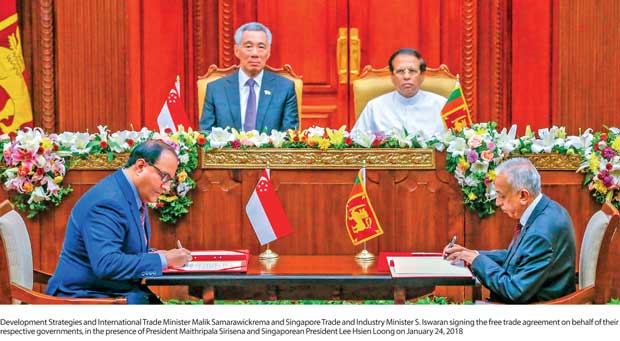20 Feb 2018 - {{hitsCtrl.values.hits}}

 In a bid to strengthen economic relations, Sri Lanka and Singapore signed a bilateral free trade agreement (FTA) on January 23, 2018. In spite of the two islands’ decades of warm diplomatic relations, Singapore comprised only 1.1 percent of Sri Lanka’s exports and 5.3 percent of imports in 2016.
In a bid to strengthen economic relations, Sri Lanka and Singapore signed a bilateral free trade agreement (FTA) on January 23, 2018. In spite of the two islands’ decades of warm diplomatic relations, Singapore comprised only 1.1 percent of Sri Lanka’s exports and 5.3 percent of imports in 2016.
The agreement underlines Singapore’s serious search for trade and investment partners beyond East Asia and it shows Singapore’s recognition of Sri Lanka’s potential as a trading hub in the fast-growing Indian Ocean region. The agreement is also an outcome of Sri Lanka’s post-conflict trade policy to boost flagging growth and to strengthen ties with East Asia.
This is Sri Lanka’s first FTA since 2005 and the most comprehensive among its handful thereof. It covers goods, services, investments, trade facilitation, intellectual property rights and government procurement.
Market access to Singapore was not a problem for Sri Lanka even before the agreement. Singapore is one of the world’s most open economies: 99 percent of all imported goods enter duty-free and there are few banned imports.
Meanwhile, Sri Lanka will eliminate tariffs on 80 percent of goods over 15 years under the agreement, which is a relatively long adjustment period. The FTA will likely benefit Sri Lanka through cheaper consumer goods and inputs, foreign direct investment (FDI) and competition. But the two countries should address a number of crucial areas in order to maximise the benefits flowing to Sri Lanka.
Singapore, which will be the 2018 Association of Southeast Asian Nations (ASEAN) chair, should support Sri Lanka’s eventual participation in the Regional Comprehensive Economic Partnership (RCEP). The RCEP promises to be the world’s largest FTA: the 16 participating countries represent 31 percent of global gross domestic product and among their numbers are the 10 ASEAN nations, China, India and Japan. Joining the RCEP offers Sri Lanka the prize of simultaneous access to an enormous regional market and dynamic Asian FDI. Participating in the RCEP is also arguably simpler for and less draining on Sri Lanka’s scarce negotiating capacity than separately negotiating 16 bilateral FTAs.
Sri Lanka is already a member of the ASEAN Regional Forum but the forum’s main purpose is discussion on security issues, not on economic ones. Attaining the ASEAN observer status is an imperative next step to Sri Lanka’s joining the RCEP.
Increasing Singaporean FDI to Sri Lanka is also a priority: only 5.3 percent of Sri Lanka’s FDI during 2014–17 came from Singapore. The investment climate has improved for Singaporean firms: the FTA rightly includes safeguards against expropriation of and discrimination against Singaporean investments, Singaporean firms can bid for large government procurement projects in Sri Lanka and Sri Lanka’s Board of Investment (BOI) is targeting Singaporean FDI in infrastructure, IT services, tourism and education.
Despite these improvements, Sri Lanka’s investment climate remains challenging. Opening a business in Sri Lanka in 2017 took an average of nine days, compared to 2.5 days in Singapore. Streamlining redundant colonial-era business regulations and demonstrating consistency in economic policy would help gain the confidence of risk-averse Singaporean investors.
Sri Lanka should additionally seek Singaporean expertise on sustainable FDI-led development. Singapore’s Economic Development Board (EDB) is famous for its network of well-staffed overseas offices of which the sole aim is to market Singapore as an investment destination. Tapping into its expertise to restructure Sri Lanka’s BOI is vital.
The Export Development Board could assist the BOI to establish its first overseas office in Singapore, which would help the BOI to step away from managing the export-processing zones and instead to refocus its capacity on investment promotion. Sri Lanka could also harness the ‘know-how’ of Singaporean firms in climate-friendly urban planning and transport, export-processing zones and logistics services.
Sri Lanka should also use this opportunity to address its substantial trade deficit with Singapore. Sri Lanka’s exports to Singapore are concentrated in gems, refined petroleum, textiles and boats; agriculture, fisheries and services exports are lagging. Sri Lankan business is concerned that the FTA will lead to ‘round-tripping’ of state-subsidised imports from ASEAN and China via Singapore.
They hope that the agreement’s rules of origin, which require at least 35 percent of value added to occur in Singapore, will be sufficient. In order to alleviate these and other concerns, Sri Lanka plans to strengthen temporary trade remedies like the World Trade Organisation-compatible safeguards and anti-dumping policies. But rather than lobby for protection, Sri Lankan firms should improve their knowledge of standards and quality such that they can export to Singapore’s high-income market.
The Sri Lanka–Singapore FTA will undoubtedly bring economic benefits for Singapore. It could also be beneficial for Sri Lanka and act as a welcome step in improving the country’s outward orientation and ties with East Asia — but the benefits will not automatically flow. Sri Lanka should take advantage of Singapore’s influence to gain the ASEAN observer status and eventual RCEP membership.
Additionally, Sri Lanka should seek Singaporean expertise on investment promotion and sustainable development. This will ensure that the FTA delivers substantial long-term dividends for Sri Lanka’s growth.
(Ganeshan Wignaraja is Chair of the Global Economy Programme at the Lakshman Kadirgamar Institute of International Relations and Strategic Studies (LKI) in Sri Lanka. Divya Hundlani is a Research Associate at the LKI)
10 Jan 2025 2 hours ago
10 Jan 2025 2 hours ago
10 Jan 2025 3 hours ago
10 Jan 2025 3 hours ago
10 Jan 2025 3 hours ago